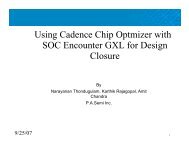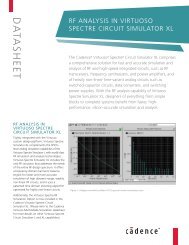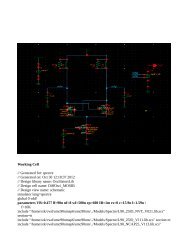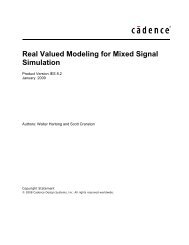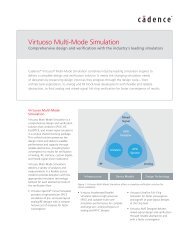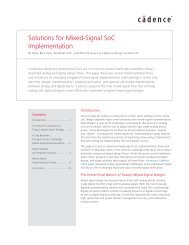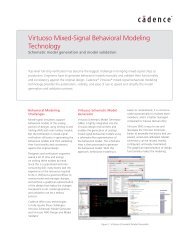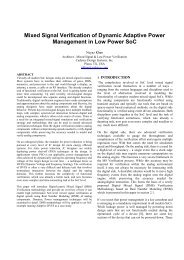Solutions for Mixed-Signal SoC Verification - Cadence Design ...
Solutions for Mixed-Signal SoC Verification - Cadence Design ...
Solutions for Mixed-Signal SoC Verification - Cadence Design ...
You also want an ePaper? Increase the reach of your titles
YUMPU automatically turns print PDFs into web optimized ePapers that Google loves.
<strong>Solutions</strong> <strong>for</strong> <strong>Mixed</strong>-<strong>Signal</strong> <strong>SoC</strong> <strong>Verification</strong><br />
New techniques that are making advanced <strong>SoC</strong> verification possible<br />
By Kishore Karnane and Sathishkumar Balasubramanian, <strong>Cadence</strong> <strong>Design</strong> Systems<br />
Per<strong>for</strong>ming full-chip verification of large mixed-signal systems on chip (<strong>SoC</strong>s) is an increasingly<br />
daunting task. As complexity grows and process nodes shrink, it’s no longer adequate to bolt<br />
together analog or digital “black boxes” that are presumed to be pre-verified. Complex analog/<br />
digital interactions can create functional errors, which delay tapeouts and lead to costly silicon<br />
re-spins. <strong>Cadence</strong> helps customers overcome these challenges with a fully integrated mixed-signal<br />
verification solution that spans basic mixed-signal simulation to comprehensive, metric-driven<br />
mixed-signal verification.<br />
Contents<br />
Introduction .................................1<br />
<strong>Mixed</strong>-<strong>Signal</strong><br />
<strong>Verification</strong> Use Models ...............2<br />
<strong>Mixed</strong>-<strong>Signal</strong><br />
<strong>Verification</strong> Challenges ................3<br />
<strong>Mixed</strong>-<strong>Signal</strong> Block and<br />
IC-Level <strong>Verification</strong> .....................3<br />
Real Number Modeling<br />
<strong>for</strong> <strong>SoC</strong> <strong>Verification</strong> ......................6<br />
Conclusion ...................................8<br />
Introduction<br />
<strong>Mixed</strong>-signal applications are among the fastest growing market segments in<br />
the electronics and semiconductor industry. From watching mobile digital TV<br />
to reading on your tablet to auto-piloted cars, consumers expect electronics to<br />
do more—in more places—than ever be<strong>for</strong>e. Driven by growth opportunities in<br />
mobile communication, networking, power management, automotive, medical,<br />
imaging, and security applications, many silicon vendors are refocusing their<br />
business on RF, high-per<strong>for</strong>mance analog and mixed-signal designs.<br />
Due to this trend, most systems-on-chip (<strong>SoC</strong>s) today are mixed-signal, and<br />
all <strong>SoC</strong>s will be mixed-signal at advanced process nodes in the near future. As<br />
process nodes shrink and the demand <strong>for</strong> integration grows, <strong>SoC</strong> designers<br />
are adding more analog circuitry and importing large blocks of mixed-signal<br />
intellectual property (IP). This escalating complexity poses severe challenges<br />
<strong>for</strong> mixed-signal <strong>SoC</strong> verification, such as incomplete <strong>SoC</strong>-level and systemlevel<br />
verification or uncertainties in verification coverage.<br />
Things were simpler in the past, when mixed-signal <strong>SoC</strong>s contained IP blocks<br />
that were designed separately and then bolted together during system<br />
integration. <strong>Design</strong>ers simply brought a handful of “black boxes”—blocks of<br />
analog circuitry that were presumed to be pre-verified—into a mostly digital<br />
<strong>SoC</strong> design. Now, however, analog IP blocks are not only growing more<br />
numerous and complex, but also increasingly contain digital control logic.<br />
Additionally, today’s mixed-signal <strong>SoC</strong>s typically contain multiple feedback<br />
loops and exhibit complex interactions between the analog and digital<br />
circuitries. As a result, teams cannot fully verify these highly integrated <strong>SoC</strong>s<br />
using a traditional black-box approach.<br />
According to industry estimates, more than 60 percent of <strong>SoC</strong> design re-spins<br />
at 45 nanometers and below are due to mixed-signal errors. A re-spin may<br />
cost an extra 5 to 10 million dollars and an 8 to 10 week delay in a product<br />
rollout, with potentially disastrous consequences. Many re-spins are due to
commonplace, avoidable errors such as inverted or disconnected signals. To avoid these errors, mixed-signal <strong>SoC</strong><br />
teams need to implement verification methodologies that can quickly scale and accurately validate the interfaces<br />
between analog and digital domains.<br />
Additionally, top-level mixed-signal <strong>SoC</strong> verification is challenging because it encompasses both analog and digital<br />
IP blocks at different levels of abstraction. The blocks could be represented in schematics, SPICE netlists, analog<br />
behavioral models, or purely digital models. This makes it essential to have a hierarchical verification approach—<br />
one that supports different levels of abstraction and different simulation engines and modeling languages.<br />
This paper presents solutions <strong>for</strong> tackling today’s mixed-signal verification challenges. After discussing common<br />
verification challenges, it looks at mixed-signal block and integrated circuit (IC)-level verification methodologies<br />
using analog behavioral modeling and combined analog and digital solvers. It then describes the use of real<br />
numbers <strong>for</strong> modeling analog functionally and using them in top-level <strong>SoC</strong> verification.<br />
Other mixed-signal white papers from <strong>Cadence</strong> discuss overall mixed-signal design challenges and mixed-signal<br />
implementation.<br />
<strong>Mixed</strong>-<strong>Signal</strong> <strong>Verification</strong> Use Models<br />
Traditionally, verification use models were different among the analog and the digital domain, and did not have any<br />
dependencies among them.<br />
Digital-centric users verify ICs primarily constructed of digital logic developed with a standard cell methodology.<br />
Analog blocks that support specific functions and protocols are integrated by importing hard analog IP. These are<br />
traditionally black boxes that provide no visibility into the IP. This is sometimes called a “big D, little A” or “digitalon-top”<br />
methodology. In this type of design methodology, verification was focused on the digital side using a pure<br />
digital simulation flow.<br />
Analog-centric users import digital logic blocks into analog, custom digital, or RF circuits. The digital blocks may<br />
provide control, calibration, or connectivity functions. This is sometimes called a “big A, little D” or “analog-ontop”<br />
methodology. In this type of implementation methodology, verification is done using traditional SPICE<br />
simulations.<br />
With today’s complex mixed-signal <strong>SoC</strong>s, users need to run full-chip verification that covers all possible analog/<br />
digital interactions. The <strong>SoC</strong>s may have many analog blocks, along with some mixed-signal blocks that could have<br />
been entire chips in previous process generations. As such, a black-box approach (which provides no visibility into<br />
signals and assumes blocks have been completely pre-verified) is no longer adequate.<br />
Digital<br />
Controls<br />
Analog<br />
Functions<br />
Traditional <strong>Mixed</strong>-signal <strong>Design</strong><br />
Physical hierarchy separates<br />
digital and analog<br />
Analog<br />
Digital<br />
<strong>Mixed</strong><br />
RF<br />
BT<br />
WiFi<br />
PMU<br />
ExM<br />
PLL<br />
BB Video Audio<br />
TV<br />
M1 M2 M3 M4<br />
LCD<br />
DSP<br />
Comm.<br />
Image<br />
Processor<br />
Application<br />
KPD<br />
USB<br />
Processor Processor SIM<br />
Memory<br />
Modern <strong>Mixed</strong>-signal <strong>Design</strong><br />
Digital and analog distributed<br />
throughout design<br />
Figure 1: Increasing complexity of mixed-signal designs<br />
Key features required <strong>for</strong> complex <strong>SoC</strong> verification include:<br />
• Block importation with full visibility into signals and design details, allowing users to debug the block if errors<br />
emerge<br />
• The ability to model discrete real data in an all-digital simulation<br />
• Integrated analog/digital debugging<br />
<strong>Solutions</strong> <strong>for</strong> <strong>Mixed</strong>-<strong>Signal</strong> <strong>SoC</strong> <strong>Verification</strong><br />
www.cadence.com 2
• Support <strong>for</strong> modeling and simulation at various levels of abstraction, including SPICE, analog behavioral<br />
modeling, and digital HDLs<br />
• An understanding of the impact of low-power design techniques—such as power shutoff—on both analog and<br />
digital IP<br />
• Single-kernel integration of analog and digital solvers<br />
• <strong>Verification</strong> planning, testbench automation, and coverage metrics applicable to the entire mixed-signal <strong>SoC</strong><br />
• Support <strong>for</strong> verification reuse and verification IP<br />
• Fast mixed-signal regression runs<br />
<strong>Mixed</strong>-<strong>Signal</strong> <strong>Verification</strong> Challenges<br />
In all types of IC design, the verification task is growing exponentially as complexity increases. For digital ICs,<br />
functional verification now takes up 70 percent of the logic design phase. Add analog and mixed-signal IP, and that<br />
task gets even more complex. Even in digital verification environments, simulation is never fast enough. Yet digital<br />
RTL simulation is orders of magnitude faster than SPICE-based analog simulation.<br />
Analog and digital simulations use fundamentally different paradigms. While digital simulators solve logical expressions<br />
sequentially by triggering events, analog simulators must solve the entire analog system matrix at every time<br />
step. Each element in the analog design can have an instantaneous influence on any other element in the matrix.<br />
There is no obvious signal flow in any direction, and time is continuous rather than discrete.<br />
The analog verification methodology is traditionally ad-hoc by nature, lacking the <strong>for</strong>malized methodology<br />
that is available on the digital side. Digital verification teams now have access to executable verification plans,<br />
constrained-random stimulus generation, testbench automation, assertions, and coverage metrics. In digital<br />
design, the metric-driven verification approach—standardized <strong>for</strong> reusability as the Universal <strong>Verification</strong><br />
Methodology (UVM)—helps engineers build confidence in the verification by increasing coverage to a desired<br />
level. On the analog side, verification is driven by directed tests run over sweeps, corners, and Monte Carlo<br />
analysis. Several analog solvers today provide low-level device checks, but there is little or no support <strong>for</strong><br />
verification planning or coverage metrics.<br />
As noted previously, many silicon re-spins stem from mixed-signal verification issues. Customer experience<br />
shows that many design failures are caused by what some might call “highly embarrassing” errors, including pin<br />
connection errors, inverted polarity, incorrect bus order, or pins connected to the wrong power domains. In the<br />
absence of simple checks, such errors are often found only in lengthy analog simulation runs, if they are found at<br />
all.<br />
Advanced low-power techniques are introducing new complications to mixed-signal verification. For example,<br />
consider a digital control logic circuit that feeds into an analog block. If the power is shut off in the digital<br />
circuit, the simulator will model data corruption internal to the power domain by setting all the internal values<br />
to Xs (unknowns). If the simulator does not understand the impact on the analog block, it may be difficult to<br />
determine whether the X states derive from the shutoff or from a functional failure.<br />
<strong>Mixed</strong>-<strong>Signal</strong> Block and IC-Level <strong>Verification</strong><br />
<strong>Verification</strong> of a mixed-signal <strong>SoC</strong> involves many different levels of abstraction. In general, transistor-level<br />
simulation with SPICE remains the gold standard <strong>for</strong> analog IP verification. While it provides very high accuracy,<br />
SPICE is much too slow <strong>for</strong> chip-level simulations, unless it is used extremely selectively.<br />
Analog behavioral modeling<br />
To achieve reasonable simulation speeds, many mixed-signal teams employ analog behavioral modeling. This<br />
approach can be 5 to 100 times faster than SPICE. The actual speedup varies widely depending on the application<br />
and the level of detail in the model. Analog behavioral models are typically written in one of the following languages:<br />
• Verilog-AMS: a mixed-signal modeling language based on IEEE 1364 Verilog that can define both analog and<br />
digital behavior, providing both continuous-time and event-driven modeling semantics<br />
• Verilog-A: the continuous time subset of Verilog-AMS, aimed at analog design<br />
<strong>Solutions</strong> <strong>for</strong> <strong>Mixed</strong>-<strong>Signal</strong> <strong>SoC</strong> <strong>Verification</strong><br />
www.cadence.com 3
• VHDL-AMS: similar in concept to Verilog-AMS, this language provides analog and mixed-signal extensions to IEEE<br />
1076 VHDL<br />
• SystemVerilog: this language is being extended to support aspects of analog behavior required <strong>for</strong> <strong>SoC</strong> verification<br />
in an ef<strong>for</strong>t also known as SV-DC[x]<br />
The creation of analog behavioral models can be challenging. Analog designers are in the best position to create<br />
these models, since they are familiar with their own circuits. But many analog designers lack the programming skills<br />
or knowledge required to construct behavioral models, and few are familiar with Verilog or VHDL. Digital designers<br />
have that familiarity, but know less about the analog circuits.<br />
Figure 2 shows the tradeoff between simulation accuracy and per<strong>for</strong>mance among SPICE, FastSPICE, analog behavioral<br />
models (Verilog-A/AMS or VHDL-AMS), real number models, and pure digital simulation. These numbers are<br />
generic and can vary significantly <strong>for</strong> different applications. Note the wide range of accuracy and per<strong>for</strong>mance that<br />
is possible <strong>for</strong> Verilog-AMS and VHDL-AMS behavioral models. Pure digital simulation can only represent an analog<br />
signal as a single logic value, but this may be sufficient <strong>for</strong> connectivity checks in mixed-signal <strong>SoC</strong>s.<br />
Accuracy<br />
Spice<br />
FastSpice<br />
Modeling Tradeoffs<br />
Conservative<br />
Verilog-A<br />
Verilog-AMS<br />
VHDL-AMS<br />
Real Number Model (RNM)<br />
Simulation Per<strong>for</strong>mance / Capacity<br />
Real number models are<br />
the most effective way to<br />
abstract AMS functioinality<br />
<strong>for</strong> full chip simulation<br />
Pure Digital<br />
Figure 2: Model accuracy vs. per<strong>for</strong>mance gain <strong>for</strong> mixed-signal simulation<br />
Another important factor is the ef<strong>for</strong>t required to set up a simulation and create the model. While SPICE simulations<br />
run slowly, they are relatively easy to set up. The time required to create a high-quality analog behavioral<br />
model, however, can range from hours to days or even weeks. Real number modeling is restricted to a signal<br />
flow approach; analog convergence is less of an issue. Typically, it takes less modeling ef<strong>for</strong>ts to develop real<br />
number models than traditional analog behavioral model.<br />
The modeling goals of analog behavioral models may differ. A per<strong>for</strong>mance model needs to precisely capture<br />
critical circuit behavior. Functional models capture circuit behavior only to the level of detail that is needed to verify<br />
the correct design functionality.<br />
Analog-centric verification use model<br />
<strong>Solutions</strong> <strong>for</strong> <strong>Mixed</strong>-<strong>Signal</strong> <strong>SoC</strong> <strong>Verification</strong><br />
Co-simulation between analog and digital solvers is one methodology that has been used <strong>for</strong> mixed-signal block<br />
and chip verification. Nonetheless, traditional co-simulation approaches have been plagued with limitations. Early<br />
co-simulation environments, <strong>for</strong> example, typically employed Verilog and SPICE operating in separate simulation<br />
kernels linked through inter-process communications (IPC). This made it difficult to keep analog and digital<br />
simulation engines in lockstep. Users typically had to partition the circuit, deal with two netlists, and cope with two<br />
disparate debugging environments.<br />
Advanced mixed-signal verification solutions such as the <strong>Cadence</strong> ® Virtuoso ® AMS <strong>Design</strong>er Simulator can<br />
achieve better per<strong>for</strong>mance than traditional co-simulation solutions. These products utilize a single, executable<br />
kernel <strong>for</strong> both analog and digital simulation engines. These solutions also provide extensive language and<br />
modeling support. They support behavioral models in Verilog-A, Verilog-AMS, VHDL-AMS, and emerging<br />
SystemVerilog-DC; transistor-level analog circuit models; and digital languages such as Verilog, VHDL, SystemC , e,<br />
and SystemVerilog-DC.<br />
www.cadence.com 4
Analog Domain <strong>Mixed</strong> <strong>Signal</strong> <strong>Verification</strong> Digital Domain<br />
Transistor level<br />
Schematic<br />
Validate Models to<br />
Circuit specs<br />
Generate RNM<br />
Model<br />
Generate Verilog-AMS<br />
Model<br />
D<br />
Real<br />
D<br />
D D<br />
D<br />
D<br />
e or SV Testbench<br />
• High per<strong>for</strong>mance, real number modeling <strong>for</strong> mixed signal verification<br />
• Models are easily ported between Virtuoso and Incisive environments<br />
• Run full-chip verification regression suites at digital speeds<br />
Benefits: Increased Predictability, Productivity and Quality (PPQ)<br />
Figure 3: Analog-centric verification use model<br />
For example, Virtuoso AMS <strong>Design</strong>er Simulator links the Virtuoso custom design plat<strong>for</strong>m with the <strong>Cadence</strong><br />
Incisive ® (digital) verification plat<strong>for</strong>m. It provides an integrated GUI, integrated embedded simulation engines, and<br />
a common verification methodology (Figure 4). It also supports simulation engines including Virtuoso Spectre ®<br />
Circuit Simulator, Virtuoso UltraSim Full-Chip Simulator, Virtuoso Accelerated Parallel Simulator, Virtuoso Spectre RF<br />
Simulation Option, and Incisive Enterprise Simulator.<br />
Analog<br />
designer<br />
<strong>Mixed</strong>-signal IP, IC<br />
Virtuoso ® plat<strong>for</strong>m<br />
Integrated GUI<br />
Integrated simulation engines<br />
Common verification methodology<br />
<strong>Mixed</strong>-signal <strong>SoC</strong><br />
Incisive ® plat<strong>for</strong>m<br />
Figure 4: Example of well-defined mixed-signal verification solution<br />
Key features of a robust analog-centric mixed-signal verification solution<br />
<strong>Solutions</strong> <strong>for</strong> <strong>Mixed</strong>-<strong>Signal</strong> <strong>SoC</strong> <strong>Verification</strong><br />
<strong>Verification</strong><br />
engineer<br />
Connect modules: Digital simulators traditionally understand only 0, 1, X, and Z, while analog simulators work<br />
with continuous values. Connect modules are used to translate digital signals to and from analog voltage levels.<br />
These bi-directional “connect” modules are inserted automatically to increase efficiency in an ideal mixed-signal<br />
verification solution.<br />
Power-smart connect modules: In an advanced low-power verification scenario, a “power-smart connect<br />
module” allows the Common Power Format (CPF), which defines digital low-power structures, to be leveraged in a<br />
mixed-signal simulation. If an analog signal’s source can be traced to a digital signal that has a CPF definition, then<br />
we can automatically insert a power-smart connect module that can distinguish between an X resulting from a<br />
functional error and an X resulting from power shutoff, nominal conditions, or power modes.<br />
Efficient data flow interaction: Another key feature is the ability <strong>for</strong> users to efficiently interchange different<br />
levels of abstraction, allowing the design to change over time from full behavioral to full transistor level.<br />
Real number modeling: Support <strong>for</strong> real number modeling (RNM) in verification plat<strong>for</strong>ms allows the simulation<br />
of discrete, floating-point real numbers that can represent voltage levels. RNM enables users to describe an analog<br />
block as a signal flow model, and then simulate it in a digital solver at near-digital simulation speeds. For analog<br />
and mixed-signal block verification, RNM can be used to speed high-frequency portions of the analog signal<br />
www.cadence.com 5
path—which take the longest to verify in simulation—while DC bias and low-frequency portions remain in SPICE.<br />
But the greatest advantage of RNM is in top-level <strong>SoC</strong> verification, where engineers can represent all electrical<br />
signals as RNM equivalents and stay within the digital simulation environment.<br />
.<br />
Digital-Centric Methodology<br />
Incisive Use Model<br />
Unified<br />
simulation<br />
and debug<br />
Analog-Centric Methodology<br />
Virtuoso Use Model<br />
Virtuoso ADE<br />
Test bench<br />
Specman<br />
Verilog<br />
Verilog<br />
A/(MS)<br />
Real Number Modeling <strong>for</strong> <strong>SoC</strong> <strong>Verification</strong><br />
Verilog<br />
SystemVerilog<br />
Analog<br />
Real Number<br />
Model<br />
Spice<br />
VHDL<br />
Figure 5: Range of simulation methodologies <strong>for</strong><br />
both analog-centric and digital-centric use models<br />
SimVision<br />
Real number modeling (RNM) models analog block operation as discrete real data. The models are based on signal<br />
flow and, hence, can be structured as event-driven.<br />
The most obvious advantage of using RNM <strong>for</strong> top-level <strong>SoC</strong> verification is that it runs nearly as fast as pure digital<br />
simulation, which is an order of magnitude faster than SPICE-based simulation or even analog behavioral modeling.<br />
This makes full-chip verification possible <strong>for</strong> large mixed-signal <strong>SoC</strong>s. Digital simulation speeds permit nightly, highvolume<br />
regression tests. With no analog engines, there are no concerns about convergence errors.<br />
Language support <strong>for</strong> real and wreal<br />
Many languages support RNM including Verilog, SystemVerilog, VHDL, e, and Verilog-AMS. The first four support<br />
a real data type, while Verilog-AMS supports wire-real, or wreal. Figure 6 shows what capabilities each language<br />
supports. (“Disciplines” differentiate domains, such as power domains, in Verilog-AMS).<br />
Verilog real<br />
• Module internal usage of real<br />
variables<br />
• No real value ports (requires real<br />
2bits/bits2real)<br />
• No support <strong>for</strong> X/Z state<br />
• No multiple wreal driver<br />
VHDL real<br />
• Real valued ports<br />
• Resolution function<br />
• Multiple drivers<br />
• User-defined types<br />
• Limited connection to analog<br />
Specman/e real<br />
• Mainly <strong>for</strong> testbenching<br />
• Random generation, coverage,<br />
checking<br />
• Direct access to analog values<br />
(receive/drive)<br />
Figure 6: Language support <strong>for</strong> real number modeling<br />
ViVa<br />
System-Verilog DC(Under Development)<br />
• User defined types<br />
• User Defined Resolutioin Functions<br />
• Definition of a net type based on its<br />
connectivity<br />
Verilog-AMS wreal<br />
• Easy interaction with analog<br />
• Direct connection to electrical nets<br />
using E2R and R2E connect modules<br />
• Disciplines association<br />
• Multiple wreal driver support<br />
• Ability <strong>for</strong> scope-based wreal<br />
resolution function specification<br />
• Identification of highimpedance/unknown<br />
state (X/Z<br />
support)<br />
<strong>Solutions</strong> <strong>for</strong> <strong>Mixed</strong>-<strong>Signal</strong> <strong>SoC</strong> <strong>Verification</strong><br />
www.cadence.com 6
Wreal is a native Verilog-AMS language feature that brings the benefits of digital signals into Verilog-AMS,<br />
including the capabilities listed in Figure 6. For example, wreal allows real variables on ports. The VHDL real data<br />
type provides similar advantages. Compared to VHDL real, Verilog-AMS wreal is more advanced in the area of<br />
connect modules, while VHDL real is slightly more flexible in terms of resolution function and user-defined types.<br />
The e language supports RNM as well as coverage constructs. This offers a direct interface to access and drive<br />
analog values to and from e.<br />
Figure 7 shows an example wreal model of a voltage-controlled oscillator (VCO).<br />
Figure 7: VCO model using Verilog-AMS wreal<br />
RNM is not, however, a replacement <strong>for</strong> analog simulation. It is not appropriate <strong>for</strong> low-level interactions involving<br />
continuous-time feedback or low-level RC coupling effects. Nor is it intended <strong>for</strong> systems that are highly sensitive<br />
to nonlinear input/output impedance interactions. And, real-to-electrical conversions require some careful consideration.<br />
If one is too conservative, there will be a large number of time points. If one is too liberal, there can be a<br />
loss of signal accuracy.<br />
Metric-driven verification<br />
module vco(vin, clk);<br />
input vin; wreal vin;<br />
output clk;<br />
reg clk;<br />
real freq,clk_delay;<br />
always @(vin) begin<br />
freq = center_freq + vco_gain*vin;<br />
clk_delay = 1.0/(2*freq);<br />
and<br />
always #(clk_delay) clk = !clk;<br />
endmodule<br />
<strong>Solutions</strong> <strong>for</strong> <strong>Mixed</strong>-<strong>Signal</strong> <strong>SoC</strong> <strong>Verification</strong><br />
Another advantage of staying within the digital simulation environment is the availability of a metric-driven verification<br />
(MDV) methodology. MDV makes it possible to use specifications to create verification plans, measure<br />
progress, and more easily determine when the verification process is complete. Functional and code coverage, checks,<br />
and assertions provide the verification metrics used to determine closure. In<strong>for</strong>mation from verification job failures,<br />
bugs, and design revisions provides insight into the status of a project.<br />
The MDV flow starts with automated planning. The plan specifies the verification environment requirements <strong>for</strong> a<br />
coverage-driven testbench language, such as SystemVerilog or e. <strong>Verification</strong> IP provides immediate access to the<br />
MDV methodology by delivering a protocol-specific verification plan and test suite. Progress reports help the verification<br />
team make adjustments to their resource allocations in people and tools, making it possible to reach closure<br />
more efficiently and measure closure more accurately.<br />
www.cadence.com 7
Figure 8: Metric-driven verification management flow<br />
With SystemVerilog and e functional coverage capabilities, MDV permits an advanced coverage-based verification<br />
and debug methodology to reach verification closure quickly. This metric-driven methodology is currently employed<br />
mainly by digital engineers, but since the majority of the <strong>SoC</strong>s today are mixed-signal, more and more verification<br />
engineers are looking to adopt this approach <strong>for</strong> mixed-signal <strong>SoC</strong>s. The mixed-signal MDV flow takes advantage<br />
of RNM to enable customers to per<strong>for</strong>m top-level <strong>SoC</strong> verification.<br />
Digital mixed-signal simulation permits real number models to run natively in a pure digital environment. Users<br />
can run full-chip verification with digital solvers <strong>for</strong> functional simulation and interconnect verification. When<br />
more accuracy is needed, users can still run transistor-level simulation or analog behavioral models in the same<br />
environment. Real number models are portable between digital (Incisive) and analog (Virtuoso) design environments.<br />
For example, a model can be developed and validated <strong>for</strong> an AMS block in the Virtuoso environment and<br />
be used during <strong>SoC</strong> verification in the Incisive environment.<br />
In recent years, tools are emerging <strong>for</strong> automating the process of model generation and validation. For example,<br />
the <strong>Cadence</strong> Virtuoso Analog <strong>Design</strong> Environment provides Schematic Model Generation and AMS <strong>Design</strong> Model<br />
Validation.<br />
There are also best practices <strong>for</strong> writing and validating real number models, many of which are described in<br />
the <strong>Mixed</strong>-<strong>Signal</strong> Methodology Guide: Advanced Methodology <strong>for</strong> AMS IP and <strong>SoC</strong> <strong>Design</strong>, <strong>Verification</strong>, and<br />
Implementation.<br />
<strong>Verification</strong> of real number models is essential. In most cases, the original transistor-level representation is used as<br />
a reference implementation. To verify the model against the reference, engineers run the same simulation on both<br />
and compare the results. Simulation setups and testbenches should be available from the block-level verification<br />
flow. Comparisons can be done manually, or highly automated <strong>for</strong> regression testing.<br />
Conclusion<br />
PDF<br />
Identify<br />
closure<br />
strategies<br />
uArch<br />
Spec<br />
React<br />
SQL<br />
metrics<br />
database<br />
vPlan<br />
Status<br />
reporting<br />
Plan<br />
Measure<br />
Failure<br />
automation<br />
<strong>Verification</strong><br />
closure?<br />
Execute<br />
Metrics<br />
analysis<br />
Full-chip verification of large mixed-signal <strong>SoC</strong>s is a daunting task. As complexity grows, it is no longer sufficient<br />
to bolt together pre-verified analog or digital “black boxes” and hope <strong>for</strong> the best. Complex interactions between<br />
analog and digital domains are resulting in more and more functional errors, which in turn are causing delayed<br />
tapeouts and silicon re-spins that may cost millions of dollars.<br />
Fortunately, there are solutions. A wide range of modeling and simulation approaches are available <strong>for</strong> analog and<br />
digital circuits. SPICE-based simulators are still needed <strong>for</strong> verifying individual analog IP blocks. When it is time to<br />
move up to the subsystem or chip level, analog behavioral models can provide up to a 100x per<strong>for</strong>mance increase.<br />
No<br />
<strong>Solutions</strong> <strong>for</strong> <strong>Mixed</strong>-<strong>Signal</strong> <strong>SoC</strong> <strong>Verification</strong><br />
www.cadence.com 8<br />
Yes<br />
Done
<strong>Solutions</strong> <strong>for</strong> <strong>Mixed</strong>-<strong>Signal</strong> <strong>SoC</strong> <strong>Verification</strong><br />
While traditional co-simulation solutions link separate analog and digital kernels, the next-generation mixed-signal<br />
verification solution should provide single-kernel execution <strong>for</strong> a variety of analog and digital solvers. It should also<br />
support a number of modeling languages, including VHDL-AMS and Verilog-AMS. Automatic insertion of “connect<br />
modules” to translate between digital and analog signals is a must.<br />
For top-level <strong>SoC</strong> verification, engineers can convert analog models into real number models. This makes it possible<br />
to stay completely within the digital simulation environment, taking advantage of metric-driven verification<br />
features such as verification planning, random test generation, coverage, and assertions. It also allows near-digital<br />
simulation speeds. Real number modeling with expanded support <strong>for</strong> the Verilog-AMS wreal data type will further<br />
reduce the verification cycle time.<br />
Thus, only a fully integrated mixed-signal verification solution—one that spans basic mixed-signal simulation<br />
to comprehensive, metric-driven mixed-signal verification—<strong>for</strong>ms the foundation <strong>for</strong> a successful and efficient<br />
methodology to develop today’s advanced mixed-signal <strong>SoC</strong>s.<br />
<strong>Cadence</strong> is trans<strong>for</strong>ming the global electronics industry through a vision called EDA360.<br />
With an application-driven approach to design, our software, hardware, IP, and services help<br />
customers realize silicon, <strong>SoC</strong>s, and complete systems efficiently and profitably. www.cadence.com<br />
© 2012 <strong>Cadence</strong> <strong>Design</strong> Systems, Inc. All rights reserved. <strong>Cadence</strong>, the <strong>Cadence</strong> logo, Incisive, Spectre, and Virtuoso are registered trademarks of<br />
<strong>Cadence</strong> <strong>Design</strong> Systems, Inc. SystemC is a trademark of the Open SystemC Initiative Inc. in the US and other countries and is used with permission.<br />
All others are properties of their respective holders. 22941 08/12 MK/LX/PDF






